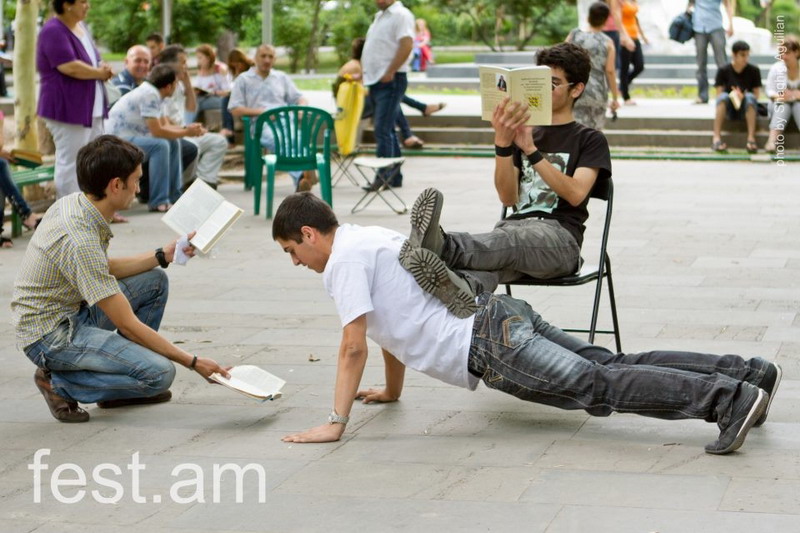
As bemused passersby watched single-file lines of insistent readers crisscross Armenia’s squares and streets with open books, it became clear. This was a flash mob.
A flash mob is a group of people who suddenly appear in a public place, perform an unusual — and, if you ask Wikipedia, seemingly pointless act — and then disperse. Usually organized using social media, flash mobs are a form of entertainment, but also artistic expression and social commentary.
People in 14 communities across Armenia took their books outside on the same June day to show that reading is important. But their statement was even larger: Youth matter and they want to be engaged in the civic lives of their countries.
“It was amazing to see so many people together around such a great message,” said Hermine Gasparyan, who participated in a flash mob in the northern city of Vanadzor. “For the first time, our youth felt like they were a part of a global movement.”
It’s not always easy being a young person in Armenia. Sure there are smart phones and movie theaters, but also a lack of jobs and limited leisure activities, especially in remote villages.
The concepts of constructive engagement and advocacy are new here, where limited resources and shaky policy makes it hard for the government to meet expectations for democracy, rule of law and social services.
To increase informed activism, and help the government respond to citizen needs, the nonprofitCounterpart International began helping Armenian organizations that were working on these issues in 2010.
It supported a youth organization — aptly named “Flash Mob Division” — in training nearly 150 youths on how to conduct social activism, from getting the word out online to using the event as a campaigning mechanism.
“We shared ideas about flash mobs as alternative ways of promoting your message,” said Eduard Levanyan, the founder and director of Flash Mob Division. “We talked about how much we can do — even without a budget, just with will — to get an idea going.”
“The training gave me the confidence that I could organize a flash mob — and reminded me that we can move an idea forward without a budget,” said Gasparyan.
Counterpart Country Director Alex Sardar says that drive paid off.
“In a society where standing out has not always been rewarded, working with local groups to reach out to the most disaffected members of a community and have them get involved in a fun, disruptive activity like a flash mob demonstrates lessons that go far beyond the event itself,” says Sardar. “Organizing, raising awareness, leading by example — all are characteristics of a model citizen.”
Guys and girls who completed their book learning in flash mobbery went forth to earn their street cred. They organized 14 flash mobs in seven regions. Overall, 313 individuals showed up to read, and make a point.
Teenagers sat shoulder to shoulder on the raised stone encircling a tree, others perched on curbs and benches. One girl read aloud, her hair whipping lightly in the wind that removed the edges from her words. On a thin sheet of plastic, a guy in a black t-shirt and sunglasses sat in the middle of the path upright, then stretched out, then — his favorite position, no doubt — surrounded by three girls.
“I loved the idea of reading in public with others,” said Aram Grigoryan, a participant in the Yerevan mob. “Usually, when I am reading on public transport, I am looked at in a negative way. An old man once told me that I should go home and read if I want to read.”
Building Community Organizations
Though a flash mob might look like a flash in the pan, strengthening and supporting the local organizations so they can deliver to and advocate for their communities are the main goals of the activity, says Counterpart’s Sardar.
The global nonprofit, which is supported by the U.S. Agency for International Development, played a critical role in strengthening Flash Mob Division, according to Levanyan. Funds acted like a megaphone in helping spread the word about these particular events, and expanding its platform in general.
The Armenian NGO is planning future events which, like the reading mobs, will unite Armenian youth as engaged citizens and creative advocates for their communities.
The government is noticing: a follow-on reading festival gained support from the Armenian Ministry of Culture and turned into a four-day read-a-thon in the heart of the capital.
With Yerevan as the UNESCO World Book Capital for 2012, the flash mobs continue to be showcased and discussed. So does the role of Armenia’s youth in standing up for something they care about and, quietly as the turn of a page, insisting that they be heard.
https://www.huffingtonpost.com

























































